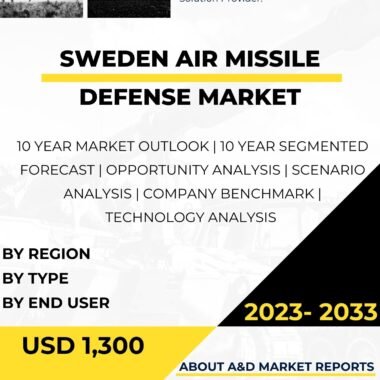Description
The AESA (Active Electronically Scanned Array) Radar market in Sweden has witnessed significant growth and interest in recent years, driven by the country’s strong technological capabilities and commitment to advancing its defense industry. AESA radar technology represents a revolutionary shift in radar systems, offering unparalleled capabilities in terms of range, precision, and agility. As a nation with a well-established aerospace and defense sector, Sweden has embraced AESA radar technology to enhance its military capabilities and maintain a competitive edge in the global radar market.
AESA radar technology differs from traditional mechanically scanned radars by using electronic beam steering instead of moving physical components. This allows for rapid and precise control of the radar beam, enabling simultaneous tracking of multiple targets and quick target acquisition. AESA radars offer improved resistance to jamming and increased survivability in hostile environments, making them vital assets in modern warfare.
In Sweden’s defense sector, AESA radar systems have been integrated into various platforms, including fighter aircraft, naval vessels, and ground-based air defense systems. One of the most prominent examples is the integration of AESA radars in the Swedish Air Force’s fleet of Gripen fighter jets. The AESA-equipped Gripen provides unmatched situational awareness, longer detection ranges, and the ability to engage multiple targets simultaneously, ensuring air superiority in contested environments.
The Swedish Navy has also embraced AESA radar technology in its surface combatants, enhancing their surveillance and detection capabilities. AESA radars on naval vessels enable better tracking of potential threats, early warning against incoming missiles, and improved maritime surveillance. The adoption of AESA radar systems in the Navy further strengthens Sweden’s ability to safeguard its territorial waters and contribute to international maritime security efforts.
Furthermore, AESA radar technology has been integrated into the country’s ground-based air defense systems. These systems serve as vital components of Sweden’s air defense posture, protecting critical assets and airspace integrity. AESA radars enhance the detection and engagement capabilities of ground-based air defense systems, providing an extra layer of protection against airborne threats.
Sweden’s commitment to developing and utilizing AESA radar technology is underpinned by its robust domestic defense industry and technological innovation. The country boasts several leading defense companies with expertise in radar systems development, allowing for the indigenous production and integration of AESA radars into various military platforms. Additionally, Sweden actively collaborates with international partners, participating in multinational projects to further enhance its radar capabilities and share knowledge with allied nations.
The AESA radar market in Sweden is not limited to the defense sector alone. AESA radars have found applications in civilian sectors as well, including air traffic control, weather monitoring, and surveillance for border security and environmental protection. The versatility and precision of AESA radar technology make it a valuable tool in these non-military applications, contributing to improved safety and efficiency in various industries.
However, like any advanced defense technology, the AESA radar market in Sweden faces certain challenges. One primary consideration is the cost of developing and deploying AESA radar systems. The development of cutting-edge AESA radars requires substantial research and development investments, and their integration into existing military platforms and infrastructures can also be financially demanding.
Additionally, maintaining the technological edge and staying ahead of rapidly evolving threats remains a constant challenge. As adversaries continue to develop countermeasures and stealth technologies, Sweden’s defense industry must invest in continuous research and development to ensure its AESA radar systems remain effective and capable of countering emerging threats.
Furthermore, the global nature of the radar market demands Sweden’s ability to compete against other technologically advanced nations. To maintain a competitive edge, Sweden’s defense industry must offer cost-effective and cutting-edge solutions while demonstrating the interoperability of its AESA radars with allied forces and international partners.
In conclusion, the AESA radar market in Sweden has witnessed remarkable growth and progress, driven by the country’s strong technological capabilities and dedication to enhancing its defense industry. AESA radar technology has become a key enabler in bolstering Sweden’s military capabilities, particularly in air and maritime domains. With AESA radars integrated into fighter aircraft, naval vessels, and ground-based air defense systems, Sweden solidifies its position as a leading player in the global radar market. By leveraging its domestic expertise, fostering international collaborations, and addressing challenges proactively, Sweden is poised to maintain its prominence in the AESA radar market, ensuring its armed forces are equipped with cutting-edge technology to safeguard the nation’s security and interests. Additionally, the versatility of AESA radar technology extends to civilian applications, contributing to improved safety and efficiency in various sectors beyond defense.




